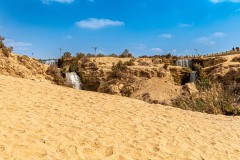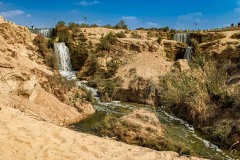Fayum is a region in Egypt located southwest of Cairo. It is known for its large agricultural area and is home to the Fayum Oasis, which has been an important source of water and fertile land for thousands of years. The Fayum region has a rich history and has been inhabited since prehistoric times.
During the Greco-Roman period, the Fayum region was a center of agriculture and commerce. It was also an important center for the worship of the crocodile god Sobek, and many temples were built in his honor.
Fayum was also known for its mummy portraits, which were painted on wooden panels and attached to mummies as a way of commemorating the deceased. In modern times, the Fayum region continues to be an important agricultural center, producing crops such as cotton, rice, and fruits.
The area is also known for its wildlife, including a variety of bird species and several types of gazelle. The Fayum has been designated as a protected area by the Egyptian government, with the aim of preserving its unique natural and cultural heritage.
Fayum history
The history of the Fayum region dates back to prehistoric times. The area was inhabited by the ancient Egyptians, who used the fertile land and water resources of the Fayum Oasis for agriculture and fishing.
During the Middle Kingdom period (2055-1650 BCE), the pharaohs built a canal connecting the Nile River to the Fayum, which allowed for better irrigation and increased agricultural productivity.
The Fayum became an important center for the production of grain and other crops, and it continued to be a key agricultural region throughout the history of ancient Egypt. During the Greco-Roman period (332 BCE- 395 CE), the Fayum region flourished as a center of agriculture and commerce. The Greeks and Romans introduced new crops and farming techniques, and the Fayum became a major source of food for the growing cities of Alexandria and Memphis. The Fayum was also an important center for religion during the Greco-Roman period.
The crocodile god Sobek was worshiped in the region, and many temples and shrines were built in his honor. The Fayum was also known for its mummy portraits, which were painted on wooden panels and attached to mummies as a way of commemorating the deceased. In the Islamic period, the Fayum continued to be an important agricultural region.
Many canals and irrigation systems were built to support farming, and the area became known for its production of cotton, rice, and other crops. In modern times, the Fayum remains an important agricultural center and is home to many small villages and towns.
What you can visit in fayum Egypt.
There are several interesting sites and attractions to visit in the Fayum region of Egypt. Here are a few:
1. Wadi El Rayan: This is a beautiful natural area located about 65 kilometers southwest of the city of Fayum. It features two man-made lakes connected by a waterfall, as well as a variety of wildlife, including several bird species and several types of gazelle.
2. Karanis: This ancient Greco-Roman city is located about 25 kilometers southeast of the city of Fayum. It was an important center of agriculture and commerce during its heyday, and today visitors can explore the ruins of the city, including the remains of several temples and a large bath complex.
3. Lake Qarun: This is the largest saltwater lake in Egypt, and it is located about 80 kilometers southwest of Cairo. It is home to a variety of fish species and attracts many bird species, making it a popular spot for birdwatching.
4. Tunis Village: This small village is located near the city of Fayum and is known for its pottery production. Visitors can watch local artisans at work and purchase unique pottery pieces to take home.
5. Hawara Pyramid: This ancient pyramid is located near the village of Hawara and is believed to have been built by the pharaoh Amenemhat III during the Middle Kingdom period. It is smaller than the famous pyramids at Giza, but it is still an impressive sight to see.
6. The Fayum Oasis: This fertile oasis is located in the heart of the Fayum region and is home to many small villages and farms. Visitors can explore the oasis and learn about the traditional way of life in this area of Egypt.



